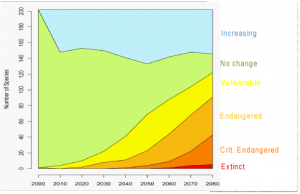NERP TE Project 3.1 - Rainforest Biodiversity (JCU)
Project summary
This project will help us manage and protect the biodiversity of the Wet Tropics by increasing our understanding of the past, present and future patterns and drivers of rainforest biodiversity. The research will increase our baseline data and knowledge while increasing our understanding of the vulnerability of our tropical forests to climate change. The project's objective is to provide knowledge that will inform evidence-based policy and management of biodiversity within the region and nationally.
The project consists of four subprojects that will each address high priority research needs:
a. Monitoring
b. Climate change vulnerability and adaptation
c. Determinants of biodiversity
d. Status, trends and future predictions
Why this research is needed
Many of the animals and plants in the rainforests of the Wet Tropics are particularly vulnerable to climate change and there is a recognised need for information that will inform sound decision making on the future of this unique area. Successful adaptation strategies should be based on an understanding of how the system works and the current status of rainforest biodiversity. This project will provide baseline monitoring data, an increased understanding of the system and projections of potential future changes and trends in biodiversity.
Research-user focus
The project will address high priority research needs of local, State and Australian Government bodies, Wet Tropics Management Authority (WTMA), Terrain NRM and Far North Queensland Regional Organisation of Councils (FNQROC).
Outcomes
- Detailed, and publicly available, mapping of species distributions, abundance patterns, and past, current and future status and trends in biodiversity and the environment.
- Increased understanding of the drivers of biodiversity that will inform evidence-based policy and management .
- Comprehensive assessment of the vulnerability of the region's biodiversity to climate change.
- Prioritisation of the conservation status of most rainforest vertebrates, significant invertebrate groups, vegetation classes and ecosystem processes.
- Provision of the necessary biodiversity data for systematic conservation planning in the region that accounts for global climate change.
Reports, Publications and News
For more information see Project 3.1 'Rainforest Biodiversity' on the NERP Tropical Ecosystems Hub site.








